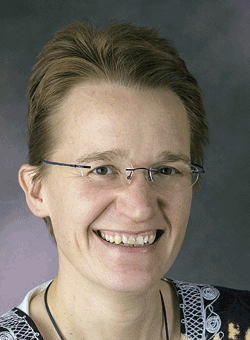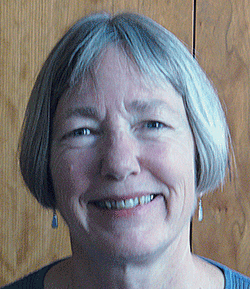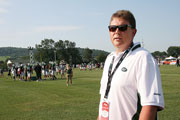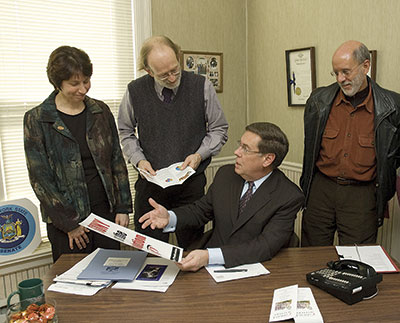Category Archives: Cortland
2009 NYSUT RA; Two UUP newsletters awarded for outstanding writing, design
|
Two newsletters produced by UUP members earned a total of five awards for outstanding writing and design. The Active Retiree and the Farmingdale Unifier were feted at the annual NYSUT journalism awards luncheon at the 2009 RA in Buffalo. The competition is sponsored by New York Teacher. The Active Retiree won Awards of Merit for general excellence and best editorial, and an honorable mention for best news story. “This well-designed, well-written and well-edited newsletter sends a clear message: Retirees as activists and difference-makers,” is how the judges described the newsletter, which is published for the more than 3,300 retiree members of UUP. The editorial “Health care should be a priority in this election,” by Judith Wishnia of SUNY Stony Brook, also earned high marks from the judges. “This editorial is not just well-written and well-organized, it does an excellent job of backing up its point with a number of factual references.” Cortland UUPer Jo Schaffer’s winning article on the state’s Rural Aging Summit was praised for its “solid reporting.” The Farmingdale Unifier, edited in 2008 by UUPer Yolanda Pauze, received a First Award for general excellence and an Award of Merit for best front page among locals with memberships between 651 and 1,000. “The clean, attractive layout and excellent content make this publication interesting and easy to read,” the judges wrote. The winning cover, which extolled the contract provisions for family leave, used “graphics and shaded boxes to add interest without being distracting. Nicely done.” — Karen L. Mattison |
Cortland UUPers make the case
| SUNY Cortland UUPers are making sure their legislators are getting the union’s message loud and clear: SUNY is the solution to the state’s fiscal woes. |
|
|
| UUPers Jamie Dangler, Dave Ritchie and Craig Little talk with Sen. Jim Seward, seated. |
|
In January, four UUPers and a local businessman met with Republican state Sen. James Seward to highlight the union’s legislative agenda. They stressed that SUNY cannot weather any further budget cuts without jeopardizing student access and the high-quality public education New Yorkers rely on. “Sen. Seward seemed to understand the general impact of the cuts to SUNY and expressed concern” with a number of the governor’s proposals, said Cortland UUPer David Ritchie. Ritchie was joined by fellow unionists Jamie Dangler, Craig Little and Dawn Van Hall, and King’s Den hair salon owner John Wetherell. According to Ritchie, Sen. Seward said he doubts the Legislature will support the proposal to eliminate the 3 percent salary increase previously negotiated by the state’s public employees unions. UUPers expect to see that raise July 2 or Sept. 1. “We used this opportunity to make sure Sen. Seward understood the full scope of the issues and UUP’s positions on them,” Dangler said. “I think it is important for legislators to get information from us. We work here and devote a huge portion of our lives to educating students and to fulfilling the broader mission of SUNY. People outside the institution don’t have the ability to see the things we do.” — Karen L. Mattison |
Journal gets international kudos

|
|
An online gender study journal produced by SUNY Cortland has been named as a top research journal in Europe by the France-based European Science Foundation.
The journal,“Wagadu: A Journal of Trans-national Women’s and Gender Studies,” offers editorials, book reviews and articles
on issues regarding gender and women’s studies.
Co-founded by Mecke Nagel, a professor in the department of philosophy, the journal was launched in 2004. Funds to start “Wagadu” (http://web.cortland.edu/ wagadu/) came from a New York State/UUP Joint Labor/Management Committee grant.
In an Aug. 13 letter, the foundation notified the college that Wagadu was selected to be listed on a European humanities reference index of top gender studies research journals.
The foundation (www.esf.org) is an association of 77 member organizations in 30 European countries dedicated to scientific research.
The proposal to start “Wagadu” was very compelling to Henry Steck, a distinguished service professor in the department of political science at SUNY Cortland. Steck, an early supporter of the project, was on the Labor/Management Committee on Technology that awarded the start-up grant for “Wagadu.”
“It was a stand-out project then and it has been widely recognized worldwide since,” Steck said. “I also was pleased at the time the award was made to professor Nagel, since so many applications we received were for projects on more technical technology concerns, many of them very good. But here was a case of an application that had an intellectual and scholarly focus.”
To read “Wagadu” online, go to http://web.cortland.edu/wagadu.
— Michael Lisi
UUPer to lead Modern Language Association

|
|
UUP member Catherine Porter Lewis, an emerita professor of French at SUNY Cortland, is set to become president of the Modern Language Association of America in January 2009.
Founded in 1883, the association promotes the study and teaching of language and literature. The association has more than 30,000 members in 100 countries. It publishes a dozen new books each year, issues four major periodicals and stages an annual convention.
Porter Lewis is currently first vice president and is a member of the association’s Executive Council.
She was elected to the council 18 months ago.
— Michael Lisi



